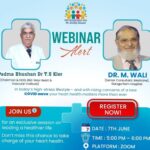Majority of the deaths occur on lower and middle-income countries
New Delhi, November 25, 2017: A recent study has indicated that non-communicable diseases (NCDs) such as heart attack, stroke, chronic respiratory diseases, and cancer account for 6 out of 10 deaths (61.8%) in India. This is alarming given the fact that the figure was 37.9% almost two decades ago. This was also the time when more than half of the deaths (53.6%) were due to communicable, maternal, neonatal, and nutritional diseases. The contribution of the group of risk factors such as obesity and lack of physical activity has increased massively to a quarter of the total disease burden in India in 2016.
NCDs are diseases of long duration and generally slow progression. The four main types of no ncommunicable diseases are cardiovascular diseases (like heart attacks and stroke), cancer, chronic respiratory diseases (such as chronic obstructed pulmonary disease and asthma) and diabetes.
Speaking about this, Padma Shri Awardee Dr K K Aggarwal, National President Indian Medical Association (IMA) and President Heart Care Foundation of India (HCFI) and Dr RN Tandon – Honorary Secretary General IMA in a joint statement, said, “NCDs currently account for almost 70% of global deaths; majority of which occur in low- and middle-income countries. India too is not untouched by this. Due to rapid urbanization, India is experiencing an epidemiological transition moving away from a predominantly communicable or infectious to a predominantly NCD pattern. Along with tobacco, harmful use of alcohol and unhealthy diet, physical inactivity has been implicated in NCDs as a major risk factor. Modern and advanced technology has certainly made life easy and convenient for us. However, what it has also done is changed our lifestyle pattern at the cost of health; we are less physically active now – sitting at a desk for a long time working on the computer, using social media on smart phones, watching TV or sitting in a meeting, all these activities promote sedentary behavior.”
A recent study has outlined that there is likely to be a steady rise in NCD losses until 2030, and then it will increase sharply. Adding to this, the value of life lost, including out-of-pocket expenditure related to these illnesses, and loss of income will likely double over the next 20 years.
Adding further, Dr Aggarwal, said, “The benefits of exercise on physical health as well as mental health are well-established and known to us all. To control non-communicable diseases and promote physical activity, IMA has proposed a campaign ‘Move Move and Move’. People should move around more often all through the day in addition to regular exercise.”
Here are a few simple ways to increase physical activity both at home and your workplace.
- Take the stairs as often as possible.
- Get off the bus one stop early and walk the rest of the way.
- Have “walk-meetings” instead of “sit-in” meetings.
- Walk to the nearby shops instead of driving.
- Stand up and walk while talking on the phone.
- Walk down to speak to your colleague instead of using the intercom/phone.
- Walk around your building for a break during the work day or during lunch.
- Buy a pedometer.
Walk 80 minutes each day; brisk walk 80 minutes a week with a speed of 80 steps per minute. This is a ‘Formula of 80’ that I have devised and which I recommend to all my patients.







